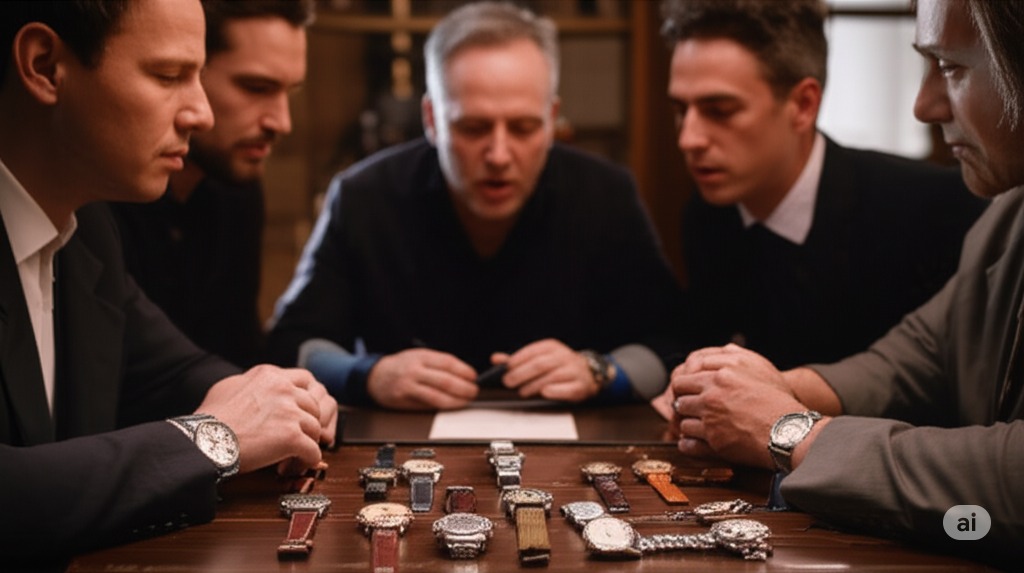The world of horology is in a perpetual state of evolution, and for watch collectors, 2025 marks a significant chapter. Navigating this landscape requires a keen understanding of shifting market dynamics, emerging trends, and the undeniable influence of technology. This year is characterized by a recalibration of the market, a renewed focus on intrinsic value, and the burgeoning role of Artificial Intelligence in shaping how enthusiasts collect, authenticate, and appreciate timepieces.
For years, the watch market, particularly the pre-owned sector, experienced an unprecedented boom. However, 2024 saw a period of correction and consolidation.[1][2] The speculative frenzy that drove prices to dizzying heights began to subside, making way for a more discerning and informed collector base.[2] While the new watch market experienced some stagnation and declining sales for major groups in certain regions like China[1][2], auction houses continued to celebrate record sales for unique and historically significant pieces, underscoring a flight to quality and rarity.[2] This signals a market where genuine enthusiasts, armed with knowledge and a passion for horology, are regaining prominence over speculative buyers.[2]
How Watch Collecting Changed in the Past Year: A Market Correction and Shifting Tastes
The past year has been a period of significant adjustment within the watch collecting sphere. The “hype” that inflated the prices of certain stainless steel sports models from powerhouse brands like Rolex, Patek Philippe, and Audemars Piguet has demonstrably cooled.[3] While these brands continue to hold strong appeal and even gain market share for their most popular models[2], the secondary market has seen prices for some previously over-inflated references move towards more realistic levels.[3] This correction is generally welcomed by seasoned collectors, as it presents opportunities to acquire pieces at more considered valuations.[3]
Several key trends have emerged or solidified in the last twelve months:
- The Rise of the “True Collector”: With the speculative tide receding, the focus has shifted back to collecting for passion, historical significance, and craftsmanship rather than purely for investment flipping.[2]
- Continued Strength in Vintage and Neo-Vintage: Vintage watches, particularly dress watches and pieces with unique provenance, are increasingly sought after.[4] The “neo-vintage” category, encompassing watches from the late 1980s to early 2000s that blend classic styling with modern reliability, is also gaining traction.[5]
- The Allure of Independent Watchmakers: Collectors are increasingly turning their attention to independent watchmakers who offer unique designs, limited production runs, and a direct connection to the artisan.[6][7][8] This trend is fueled by a desire for something different from mainstream offerings and an appreciation for innovative horology.[6][7]
- A Return to Classic Proportions and Designs: While larger watches still have their place, there’s a noticeable shift towards smaller, more classic case sizes (typically 36mm-40mm).[9][10] This aligns with the growing interest in vintage aesthetics and a desire for more versatile and comfortable daily wear.[9][10] Dress watches are also making a significant comeback, challenging the long-standing dominance of sports models for everyday wear.[4][10]
- Color and Material Innovation: Dials in vibrant and varied colors continue to be a strong trend, offering collectors a way to express personal style.[11][12][13] Brands are also experimenting with new case materials, including colored ceramics and exotic alloys.[11] We’re also seeing more interest in precious metals like gold and two-tone designs.[10]
- Emphasis on Sustainability and Ethical Practices: Like other luxury sectors, the watch industry is seeing a growing focus on sustainability, with brands highlighting responsibly sourced materials and eco-friendly manufacturing processes.[9][13]
However, it’s important to note that the market for new watches has faced challenges, with Swiss watch exports showing a decline in 2024, particularly in Asian markets like Hong Kong and China.[1] Price increases for new models, attributed to rising costs of labor, materials (especially precious metals), and energy, are also a factor for consumers to consider.[1][2] Despite this, the high-end segment (watches above CHF 3,000) has proven more resilient.[1]
The Influence of AI on Watch Collectors: A New Frontier
Artificial Intelligence is no longer a futuristic concept but an increasingly tangible force within the watch collecting hobby and the broader luxury watch industry. Its influence is being felt across various aspects, offering collectors new tools and insights:
- Authentication and Counterfeit Detection: This is arguably one of the most significant impacts of AI. Sophisticated AI algorithms are being trained on vast databases of authentic and counterfeit watches to identify fakes with a high degree of accuracy.[14][15][16][17] AI can analyze minute details, such as engraving patterns, dial printing, and material composition, that might escape even the experienced human eye.[14][15] Several platforms and apps are emerging, like TrustWatch and watchID, that leverage AI for watch authentication, offering collectors greater peace of mind, especially when navigating the pre-owned market.[16][17][18][19][20][21] Some AI tools even combine analysis with blockchain technology to create immutable records of a watch’s provenance, further enhancing transparency and security.[14][15]
- Valuation and Market Analysis: AI-powered tools are being developed to provide more accurate and up-to-date watch valuations.[22] These systems analyze data from major marketplaces, auction results, and historical sales trends to offer realistic price assessments.[22] Watch Valuator AI, for example, uses data from Chrono24, eBay, and WatchCharts to provide conservative valuations and track brand popularity trends.[22] This empowers collectors with better information when buying, selling, or understanding the current market value of their pieces. AI can also analyze broader market dynamics, including economic indicators and collector sentiment, to provide dynamic pricing insights.[23]
- Personalized Recommendations and Discovery: AI algorithms can analyze a collector’s browsing history, purchase patterns, and even social media activity to provide highly personalized watch recommendations.[14] This can help enthusiasts discover new brands, models, or specific variations that align with their tastes but might have otherwise been overlooked.[14]
- Enhanced Quality Control and Design: While perhaps less directly visible to the collector, AI is playing a role in the manufacturing process. AI-powered systems can detect microscopic flaws in watch movements and components, ensuring higher quality standards.[14] AI is also being used as a design tool, analyzing market trends and consumer preferences to suggest innovative features and aesthetic elements, potentially leading to novel watch designs.[14][24]
- Inventory Management and Trend Forecasting: For brands and retailers, AI is revolutionizing inventory management by predicting demand for specific models based on historical data and social media trends.[14] This can lead to better availability of popular pieces.
- Predictive Maintenance: AI is also being explored for predictive maintenance in high-end timepieces.[24][25] Sensors within a watch could provide data that AI analyzes to predict when servicing is needed, helping to maintain the watch’s condition and value.[24][25]
Despite the benefits, the integration of AI also sparks debate. Some purists express concern that an over-reliance on AI in design and manufacturing could diminish the value of traditional human craftsmanship.[14] However, proponents argue that AI can free artisans from repetitive tasks, allowing them to focus on the creative and intricate aspects of watchmaking that require a human touch.[14] Furthermore, ensuring data privacy and ethical use of customer data collected by AI systems is crucial for maintaining consumer trust.[14]
Navigating Watch Collecting in 2025 and Beyond
For the passionate watch collector in 2025, the landscape is one of nuanced opportunity. The market correction has brought a welcome dose of realism, favoring informed decisions over speculative gambles. The key is to focus on watches that offer genuine horological value, compelling design, and a connection to a brand’s heritage or an independent maker’s vision.
Key Takeaways for Collectors in 2025:
- Prioritize Knowledge and Passion: In a market less driven by hype, a deep understanding of brands, movements, and historical context is invaluable. Collect what you love and what genuinely interests you.
- Embrace Value, Not Just Price Tags: While high-end pieces will always command attention, explore brands and models that offer exceptional craftsmanship and design at various price points. The “value for money” proposition is becoming increasingly important.[2]
- Consider Independents and Microbrands: These makers often provide innovation, exclusivity, and a more personal connection.[6][7][8]
- Don’t Discount Vintage and Neo-Vintage: These segments offer character, history, and often, more accessible entry points into collecting significant timepieces.[4][5]
- Leverage AI Tools Wisely: Utilize AI-powered resources for authentication, valuation, and discovery, but always complement them with your own research and, where possible, expert human advice.[15][16][18][22]
- Stay Informed on Market Trends: Keep an eye on auction results, industry reports, and publications to understand the evolving preferences and values within the collecting community.[1][2]
- Think Long-Term: While investment potential can be a factor, true collecting satisfaction often comes from building a collection that reflects personal taste and will be cherished for years to come.[7][26]
The world of watch collecting in 2025 is dynamic and multifaceted. It’s a market that rewards diligence, passion, and an appreciation for the artistry and engineering that define fine watchmaking. By staying informed, embracing new technologies responsibly, and focusing on intrinsic quality, collectors can continue to find immense joy and satisfaction in this timeless pursuit.
Sources:
- dailywatch.com
- swisswatches-magazine.com
- chrono24.com
- coolmaterial.com
- revolutionwatch.com
- le-monde-edmond.com
- luxurytribune.com
- blockapps.net
- crownvintage.com.au
- youtube.com
- therake.com
- wempe.com
- chronext.fr
- bobswatches.com
- blockapps.net
- hokentech.tech
- wav.tech
- deepgram.com
- genai.works
- legitapp.com
- creator-spring.com
- yeschat.ai
- goldammer.me
- mrwatchief.com
- ivy.partners
- agility-research.com

